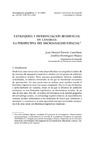Please use this identifier to cite or link to this item:
https://accedacris.ulpgc.es/jspui/handle/10553/73879
| DC Field | Value | Language |
|---|---|---|
| dc.contributor.author | Parreño Castellano, Juan Manuel | en_US |
| dc.contributor.author | Domínguez Mujica, Josefina | en_US |
| dc.date.accessioned | 2020-07-30T17:09:19Z | - |
| dc.date.available | 2020-07-30T17:09:19Z | - |
| dc.date.issued | 2008 | en_US |
| dc.identifier.issn | 1989-9890 | en_US |
| dc.identifier.other | WoS | - |
| dc.identifier.uri | https://accedacris.ulpgc.es/handle/10553/73879 | - |
| dc.description.abstract | En la tradición geográfica, una de las formas de abordar la diferenciación social del espacio ha sido la de estudiar el comportamiento territorial de los grupos de población que se pueden establecer a partir de determinados atributos. En la actualidad el tratamiento de la información estadística a microescala y la utilización de los Sistemas de Información Geográfica están permitiendo ahondar en sus planteamientos y avanzar en la comprensión de la distribución territorial de los grupos sociales. En el archipiélago canario, uno de los fenómenos que ha alcanzado una mayor importancia en la evolución demográfica reciente ha sido el incremento de la población de nacionalidad extranjera. En este artículo analizamos las pautas de localización de dicha población e intentamos medir si se están generando procesos de segregación geográfica. Nuestra finalidad es contrastar si este ámbito espacial, situado en la ultraperiferia de la Unión Europea, de clara vocación turística, y que ha recibido en los últimos años cuantiosos flujos de inmigración, se ve afectado por procesos territoriales semejantes al de otras zonas migratorias «maduras» de Europa. | en_US |
| dc.description.abstract | In the geographical background, one of the ways to focus on the social differentiation of the territory has been to analyses the spatial behaviour of the population groups which can be established from specific characteristics. Nowadays, the use of statistic information at micro-scale and the Geographical Information System allow to thoroughly study the understanding of the territorial distribution of these social groups. In the Canary Islands, one of the most important aspects in the current demographic evolution has been the increase of foreign people. In this paper, we analyse the locative patterns of this population, and we try to assess whether segregation processes exist or not. Our aim is to confirm whether a tourist region such as the Canary Islands, located in the ultra-periphery of the European Union and with large immigration flows during the last years, is affected by a similar territorial process than other consolidated migratory areas of Europe. | en_US |
| dc.language | spa | en_US |
| dc.relation | Repercuciones Socio-Económicas y Territoriales de la Vivienda Extranjera en Canarias. | en_US |
| dc.relation.ispartof | Investigaciones Geograficas | en_US |
| dc.source | Investigaciones Geograficas [ISSN 1989-9890] (45), p. 163-199, (2008) | en_US |
| dc.subject | 5403 Geografía humana | en_US |
| dc.subject.other | Segregation | en_US |
| dc.subject.other | Cities | en_US |
| dc.subject.other | Microanálisis | en_US |
| dc.subject.other | Geodemografía | en_US |
| dc.subject.other | SIG | en_US |
| dc.subject.other | Inmigración | en_US |
| dc.subject.other | Segregación residencial | en_US |
| dc.title | Extranjería y diferenciación residencial en Canarias: la perspectiva del microanálisis espacial | en_US |
| dc.title.alternative | Alienation and residential differentiation in The Canary Islands: from the perspective of spatial microanalysis | en_US |
| dc.type | info:eu-repo/semantics/Article | en_US |
| dc.type | Article | en_US |
| dc.identifier.doi | 10.14198/INGEO2008.45.07 | en_US |
| dc.identifier.isi | 000215959700007 | - |
| dc.description.lastpage | 199 | en_US |
| dc.identifier.issue | 45 | - |
| dc.description.firstpage | 163 | en_US |
| dc.investigacion | Artes y Humanidades | en_US |
| dc.type2 | Artículo | en_US |
| dc.contributor.daisngid | 32075334 | - |
| dc.contributor.daisngid | 32145598 | - |
| dc.description.numberofpages | 37 | en_US |
| dc.utils.revision | Sí | en_US |
| dc.contributor.wosstandard | WOS:Castellano, JMP | - |
| dc.contributor.wosstandard | WOS:Mujica, JD | - |
| dc.date.coverdate | 2008 | en_US |
| dc.identifier.ulpgc | Sí | es |
| dc.description.esci | ESCI | |
| dc.description.erihplus | ERIH PLUS | |
| item.fulltext | Con texto completo | - |
| item.grantfulltext | open | - |
| crisitem.author.dept | GIR IATEXT: Sociedades y Espacios Atlánticos | - |
| crisitem.author.dept | IU de Análisis y Aplicaciones Textuales | - |
| crisitem.author.dept | Departamento de Geografía | - |
| crisitem.author.dept | GIR IATEXT: Sociedades y Espacios Atlánticos | - |
| crisitem.author.dept | IU de Análisis y Aplicaciones Textuales | - |
| crisitem.author.dept | Departamento de Geografía | - |
| crisitem.author.orcid | 0000-0002-1082-456X | - |
| crisitem.author.orcid | 0000-0001-7460-5553 | - |
| crisitem.author.parentorg | IU de Análisis y Aplicaciones Textuales | - |
| crisitem.author.parentorg | IU de Análisis y Aplicaciones Textuales | - |
| crisitem.author.fullName | Parreño Castellano, Juan Manuel | - |
| crisitem.author.fullName | Domínguez Mujica, Josefina | - |
| crisitem.project.principalinvestigator | Domínguez Mujica, Josefina | - |
| Appears in Collections: | Artículos | |
WEB OF SCIENCETM
Citations
8
checked on Feb 25, 2024
Page view(s)
150
checked on Nov 1, 2024
Download(s)
119
checked on Nov 1, 2024
Google ScholarTM
Check
Altmetric
Share
Export metadata
Items in accedaCRIS are protected by copyright, with all rights reserved, unless otherwise indicated.
